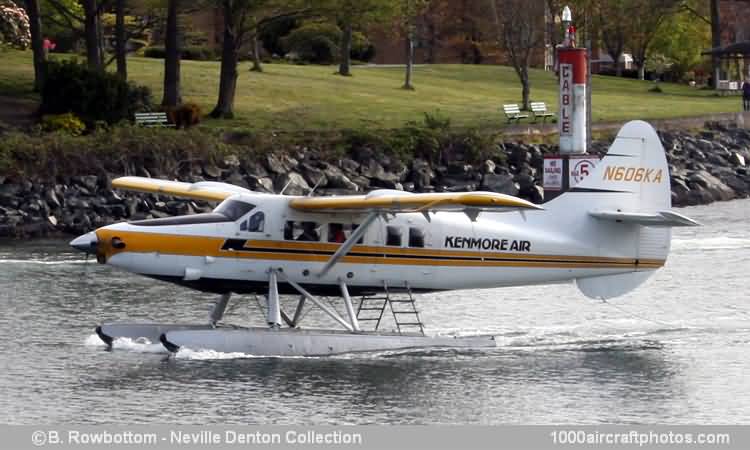06/30/2010. Remarks by Johan Visschedijk: "The Ontario Provincial Air Service (OPAS) needs were so satisfied by the DHC-2 Beaver (eventually it bought 44 of them) that de Havilland Canada (DHC) was informed that if it would build a comparable aircraft of twice the capacity OPAS would take 20 of them. With this encouragement DHC proceeded and on November 29, 1950, the construction of a prototype was authorized.
The DHC-3, originally named King Beaver but later changed to Otter, followed the Beaver configuration closely but full-span slotted-flaps with ailerons incorporated in their outer portion were introduced. A major problem was the supply of a suitable power plant. Some geared Pratt & Whitney Wasps were located, and Canadian Pratt & Whitney Aircraft agreed to put the engine into production. Ejection cooling was introduced to give adequate cooling during the climb. Richard D. Hiscocks and Frederick H. Buller were largely responsible for the design of the Otter.
The Otter was designed to operate from a 1,000 ft (305 m) landing strip and carry a payload of 3,153 lb (1,430 kg) for 200 mls (313 km) without reserves or 2,325 lb (1,055 kg) for 882 mls (1,419 km). A double freight-loading door was provided on the port side and an air-drop hatch at the rear of the cabin. The cabin seats for nine passengers could be folded against the walls when cargo was carried. There was accommodation for a crew of two.
The prototype, CF-DYK-X, was first flown on wheels at Downsview on December 12, 1951, by George Neal. The original small vertical tail was enlarged and a fence installed on the wing before the type was certificated on November 5, 1952. The approval took longer than usual because the Otter had been designed to ICAO Category D requirements, possibly the only type to comply with them, and then had to be approved to CAA requirements. Early production Otters were sold to the RCAF and Canadian civil operators as well as to OPAS; Wideroe's Flyveselskap A/S of Norway was actually the first foreign operator of the type.
In the summer of 1953 the US Army had invited DHC to participate in a demonstration at Fort Bragg, North Carolina, designated Operation Skydrop 2, intended to show the capabilities of a number of helicopters and fixed-wing aircraft in the transport of supplies. It was the Otter's daily performance from a short strip, and with no maintenance problems, that convinced the US Army that it was a real workhorse, and orders for six, essentially civil Otters, designated YU-1, were given.
These were followed by further orders totaling another 155 (about one third of the total Otter production), while the USN purchased 14. The RCAF operated 69 Otters and four of them were assigned to the UN Emergency Force in the Middle East. Many RCAF Otters were assigned to search and rescue operations and those still remaining in service are largely operated by reserve units.
In service the Otter did its job well, often under extreme climatic conditions. It operated on wheels, floats, skis, amphibious floats and wheel/skis, as well as using oversized low-pressure tires for landing on rough terrain. Two hydraulic-system failures, due to fluid contamination, caused a sudden flap retraction and the loss of two aircraft in 1956. A modification was introduced to enable control to be maintained under such conditions but no further failure occurred.
The Otter was used in exploratory work in the Antarctic by the USN and by Belgium and Britain, and its use by the US Army led to a new concept in moving and supplying troops in the field. The OPAS used the type extensively in developing its water-bombing techniques. Initially a cylindrical tank holding 96 gal (363 l) was mounted above each float. This was filled automatically during a touch-and-go alighting and dumped by rotating the tank over the fire site. Later, a single 252 gal (954 l) streamlined tank was mounted centrally between the floats but filled and dumped the same way. Still later, water tanks were incorporated integrally within the floats.
One Otter, RCAF 3682, was extensively modified by DHC for STOL experiments, while another one, CF-MES-X, was re-engined by Cox Air Resources of Edmonton, and a Canadian Pratt & Whitney PT6A-27 turboprop of 662 hp was installed driving a Hartzell reversible-pitch propeller. It has been designated the DHC-3-T Turbo-Otter and first flew on September 26, 1978, at Namao, near Edmonton. While its loaded weight remains the same, its empty weight is reduced to 4,100 lb (1,861 kg) and its useful load increased accordingly.
Since numerous have been converted to turboprop versions, including the pictured one that was produced for the RCAF under serial 3679, taken on strength on March 10, 1954. After an uneventful service it was struck off charge on March 12, 1963, six weeks later, April 24, it was delivered to the Indian AF, and serialed BM-1001 it was taken on strength on August 10, 1963. Thirty years later it was sold to Canada, where it remained till it was acquired by Kenmore Air Harbor Inc. of Kenmore, Washington, USA, being registered as N606KA on April 25, 1995.
Subsequently Kenmore had N606KA re-engined with a Pratt & Whitney PT6A and as a DHC-3-T Turbo-Otter the aircraft received a new CofA on September 10, 1999. On June 1, 2006 it suffered extensively damage when on approach to Port Townsend, Washington, the pilot decided to make a precautionary landing due to deteriorating visibility. The aircraft landed hard, the fuselage, fuselage skin and the dorsal stabilizer were deformed, so the pilot decided to taxi the aircraft to Port Townsend. The aircraft was subsequently repaired, while also scenic windows were installed, and returned to service in spring 2007."
